![に – Marking Time, Destinations, and Recipients in Japanese [JLPT N5]](http://hirakan.com/cdn/shop/articles/ni-marking-destination.jpg?v=1762667846&width=1100)
に – Marking Time, Destinations, and Recipients in Japanese [JLPT N5]
Aktie
Quick Summary
Meaning: The particle に marks a point in time (at/on), a destination you reach (to/into), or a target/recipient of an action (to/for).
How to Use: Put に after the Time, Place, or Person you’re pointing to, before the verb.
Example:
- 七時にロボットに電話します。
- Shichi-ji ni robotto ni denwa shimasu.
- I call a robot at seven o’clock.
Overview
The particle に is a small marker with a clear job: it tells us when something happens, where someone ends up, or who receives an action.
Use に for a point in time like “at 7,” “on Sunday,” or “on May 1.” It does not show a length of time. You often don’t use に with broad time words like 今日 (kyou, today), 明日 (ashita, tomorrow), or 毎日 (mainichi, every day).
Use に for a destination with motion verbs like 行きます (ikimasu, to go), 来ます (kimasu, to come), and 帰ります (kaerimasu, to return). It’s the final place you reach, like “to Tokyo,” “into the room,” or “to the station.”
Use に for a target/recipient with verbs like あげます (agemasu, to give), 言います (iimasu, to say), 電話します (denwa shimasu, to call), 会います (aimasu, to meet), and メールします (meeru shimasu, to email). Here に can feel like “to” or “for.”
Common confusions: へ (e) also marks direction, but に focuses on the destination. And で (de) marks the place of an action (“at/in where something happens”), not the time, destination, or recipient.
Structure / Formation
Base Patterns
- Time + に + V
- Place + に + V (motion: 行く / 来る / 帰る)
- Person + に + V (give/say/call/meet)
Time に (point in time)
Attach に to a specific time or date. Think “at” or “on.”
- 日曜日におばあさんはゲームをします。
- Nichiyoubi ni obaasan wa geemu o shimasu.
- On Sunday, Grandma plays video games.
Use に with hours, minutes, days, and dates. Usually skip に with 今日 (kyou, today), 明日 (ashita, tomorrow), 昨日 (kinou, yesterday), and 毎日 (mainichi, every day).
Destination に (final place)
Attach に to the place you arrive at with motion verbs like 行きます (ikimasu, to go), 来ます (kimasu, to come), 帰ります (kaerimasu, to return).
- 私の猫は月に行きます。
- Watashi no neko wa tsuki ni ikimasu.
- My cat goes to the moon.
Tip: へ (e) also shows direction, but に highlights the goal you reach. In beginner speech, に is the safer default for destinations.
Target / Recipient に
Attach に to the person who receives or is targeted by the action: あげます (agemasu, to give), 言います (iimasu, to say), 電話します (denwa shimasu, to call), 会います (aimasu, to meet), メールします (meeru shimasu, to email).
- 先生に歌います。
- Sensei ni utaimasu.
- I sing to my teacher.
Usage Tips
に vs で: に marks time/destination/recipient. で marks the place where the action happens. Example idea: “at the park” (で) is the stage of the action; “to the park” (に) is the goal.
Optional に with some time words: With words like 今 (ima, now), 今日 (kyou, today), 明日 (ashita, tomorrow), に is usually dropped. With exact times like 七時 (shichi-ji, seven o’clock) or 5月1日 (gogatsu tsuitachi, May 1st), に is used.
Example Sentences
- 五時にカエルはダンスします。
- Go-ji ni kaeru wa dansu shimasu.
- At five o’clock, a frog dances.
- 金魚は学校に行きます。
- Kingyo wa gakkou ni ikimasu.
- The goldfish goes to school.
- 私はタコに花をあげます。
- Watashi wa tako ni hana o agemasu.
- I give flowers to an octopus.
- ドラゴンは七時に家に帰ります。
- Doragon wa shichi-ji ni ie ni kaerimasu.
- The dragon returns home at seven o’clock.
- 日曜日にペンギンに会います。
- Nichiyoubi ni pengin ni aimasu.
- On Sunday, I meet a penguin.
Quick Practice
(Answers and explanations are right under this section.)
Multiple-Choice
1. Choose the best sentence: “At three o’clock, the turtle studies Japanese.”
- A. 三時にカメは日本語を勉強します。(San-ji ni kame wa nihongo o benkyou shimasu.)
- B. 三時でカメは日本語を勉強します。(San-ji de kame wa nihongo o benkyou shimasu.)
- C. 三時とカメは日本語を勉強します。(San-ji to kame wa nihongo o benkyou shimasu.)
- D. 三時カメは日本語を勉強します。(San-ji kame wa nihongo o benkyou shimasu.)
2. Choose the sentence that correctly uses に to mark the destination.
- A. おばけは図書館に行きます。(Obake wa toshokan ni ikimasu.)
- B. おばけは図書館へ行きます。(Obake wa toshokan e ikimasu.)
- C. おばけは図書館で行きます。(Obake wa toshokan de ikimasu.)
- D. おばけは図書館と行きます。(Obake wa toshokan to ikimasu.)
3. Choose the correct sentence: “I give candy to the robot.”
- A. 私はロボットであめをあげます。(Watashi wa robotto de ame o agemasu.)
- B. 私はロボットにあめをあげます。(Watashi wa robotto ni ame o agemasu.)
- C. 私はロボットとあめをあげます。(Watashi wa robotto to ame o agemasu.)
- D. 私はロボットへあめをあげます。(Watashi wa robotto e ame o agemasu.)
4. Choose the best sentence: “Tomorrow, I will meet Grandma.”
- A. 明日におばあさんに会います。(Ashita ni, obaasan ni aimasu.)
- B. 明日、おばあさんを会います。(Ashita, obaasan o aimasu.)
- C. 明日、おばあさんに会います。(Ashita, obaasan ni aimasu.)
- D. 明日でおばあさんに会います。(Ashita de obaasan ni aimasu.)
5. Choose the correct sentence with both time and destination marked by に: “At six o’clock, the fox comes to the station.”
- A. 六時にキツネは駅に来ます。(Roku-ji ni kitsune wa eki ni kimasu.)
- B. 六時でキツネは駅に来ます。(Roku-ji de kitsune wa eki ni kimasu.)
- C. 六時にキツネは駅で来ます。(Roku-ji ni kitsune wa eki de kimasu.)
- D. 六時キツネは駅に来ます。(Roku-ji kitsune wa eki ni kimasu.)
Spot-the-Error
6. One sentence has a に mistake. Which one?
- A. 毎日に犬にメールします。(Mainichi ni inu ni meeru shimasu.)
- B. 七時に犬にメールします。(Shichi-ji ni inu ni meeru shimasu.)
- C. 今日、犬にメールします。(Kyou, inu ni meeru shimasu.)
7. One sentence has a に mistake. Which one?
- A. ロボットは学校に行きます。(Robotto wa gakkou ni ikimasu.)
- B. ロボットは学校で行きます。(Robotto wa gakkou de ikimasu.)
- C. ロボットは学校へ行きます。(Robotto wa gakkou e ikimasu.)
Translation
8. Translate into Japanese using に: “On Sunday, the panda goes to the museum.”
9. Translate into Japanese using に: “At seven o’clock, I say ‘good morning’ to my neighbor.”
10. Translate into Japanese using に: “At the station, I give a banana to the monkey.”
Answers and Explanations
- A. 三時にカメは日本語を勉強します。(San-ji ni kame wa nihongo o benkyou shimasu.) — に marks a specific point in time (at three o’clock).
- A. おばけは図書館に行きます。(Obake wa toshokan ni ikimasu.) — に marks the destination you reach; the question asked specifically for に.
- B. 私はロボットにあめをあげます。(Watashi wa robotto ni ame o agemasu.) — に marks the recipient of giving.
- C. 明日、おばあさんに会います。(Ashita, obaasan ni aimasu.) — We usually drop に after 明日, but use に for the person you meet.
- A. 六時にキツネは駅に来ます。(Roku-ji ni kitsune wa eki ni kimasu.) — に marks both the time point and the destination.
- A. 毎日に犬にメールします。(Mainichi ni inu ni meeru shimasu.) — Broad time words like 毎日 usually do not take に; say 毎日、犬にメールします。
- B. ロボットは学校で行きます。(Robotto wa gakkou de ikimasu.) — Destination should be marked by に (or へ), not で.
- 日曜日にパンダは博物館に行きます。(Nichiyoubi ni panda wa hakubutsukan ni ikimasu.) — に marks the day and the destination.
- 七時にとなりの人に「おはよう」と言います。(Shichi-ji ni tonari no hito ni "ohayou" to iimasu.) — に marks the time and the person you speak to.
- 私は駅で猿にバナナをあげます。(Watashi wa eki de saru ni banana o agemasu.) — に marks the recipient (猿), while で marks the place where the action happens.
Related Posts
-
![へ – Marking Direction ‘Toward’ in Japanese [JLPT N5]](//hirakan.com/cdn/shop/articles/he-marking-direction.jpg?v=1762667986&width=170)
へ – Marking Direction ‘Toward’ in Japanese [JLPT N5]
Quick Summary Meaning: The particle へ marks direction or “toward” a place or person. It points where something is hea...
-
![の – Possession and Noun Linking in Japanese [JLPT N5]](//hirakan.com/cdn/shop/articles/no-possession-and-noun-linking.jpg?v=1761961297&width=170)
の – Possession and Noun Linking in Japanese [JLPT N5]
Quick Summary Meaning: Links two nouns to show possession, belonging, or description. Often reads as “’s” or “of....
-
![を – Marking the Direct Object in Japanese [JLPT N5]](//hirakan.com/cdn/shop/articles/o-direct-object.jpg?v=1761960990&width=170)
を – Marking the Direct Object in Japanese [JLPT N5]
Quick Summary Meaning: を marks the direct object — the thing that receives the action of a verb. It’s pronounced ...
-
![が – Marking the Subject ('Who/What') in Japanese [JLPT N5]](//hirakan.com/cdn/shop/articles/ga-subject-marker_60f30f70-6ca5-47ee-9a00-3646195d7d3c.jpg?v=1761386355&width=170)
が – Marking the Subject ('Who/What') in Japanese [JLPT N5]
Quick Summary Meaning: The particle が marks the subject of a sentence and highlights new or focused information (an...
-
![は (wa) – Topic Marker and Contrast in Japanese [JLPT N5]](//hirakan.com/cdn/shop/articles/wa-topic-marker.jpg?v=1761385996&width=170)
は (wa) – Topic Marker and Contrast in Japanese [JLPT N5]
Quick Summary Meaning: Marks the topic of the sentence — what you’re talking about. Often feels like “as for...” in E...
-
![じゃない・ではありません – Expressing 'Is/Was Not' in Japanese [JLPT N5]](//hirakan.com/cdn/shop/articles/janai-dehaarimasen_2594963b-531e-4f4d-a9b0-361010e0a720.jpg?v=1760865884&width=170)
じゃない・ではありません – Expressing 'Is/Was Not' in Japanese [JLPT N5]
Quick Summary Meaning: The negative of the copula “to be.” Say “is not” or “was not” with nouns and na-adjectives. Ho...
-
![だ・です/だった・でした – Saying ‘to be’ in Japanese [JLPT N5]](//hirakan.com/cdn/shop/articles/da-desu-datta-deshita_58bbc732-53fd-48da-83c7-4e477e7cc0b2.jpg?v=1760864506&width=170)
だ・です/だった・でした – Saying ‘to be’ in Japanese [JLPT N5]
Quick Summary Meaning: The Japanese copula — the basic “to be.” It links a topic to a noun or a na-adjective to state...
-

Common Japanese Onomatopoeia: Essential Words You’ll Hear Everywhere
If you spend any time in Japan, you’ll hear onomatopoeia everywhere: on TV, in everyday conversations, in manga, and ...
-

How to Say “To Increase” and “To Decrease” in Japanese: With Examples
You've noticed there are multiple ways to say “to increase” or "to decrease" in Japanese. Between transitive and intr...
-

How to Say "Police Officer" in Japanese: Common Terms and Slang
There are several ways to say "police officer" in Japanese, and each one has a different level of formality and usage...
-
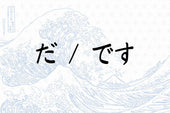
Understanding だ (da) and です (desu) in Japanese: Meaning and Usage
When learning Japanese, one of the first things you’ll come across is だ (da) and です (desu). These words don’t have a ...
-
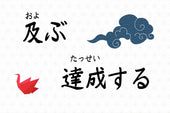
Difference Between 及ぶ (およぶ) and 達成する (たっせいする)
Both 及ぶ and 達成する can relate to "reaching" or "achieving" something, but they have distinct nuances and usage contexts...
-

JLPT N5 Study Guide: A Beginner's Roadmap to Acing the Test
If you’ve just started learning Japanese and are aiming to ace the JLPT N5, you’ll need a solid study guide to help y...
-

Beginner's Guide to Japanese Particles: Learn the Basics
TL;DR: Japanese particles are crucial for structuring sentences, acting like conjunctions or prepositions in English...
-

JLPT N5 Vocabulary List - All 748 Words You Need to Know
Vocabulary is the foundation of any language, and Japanese is no exception. The more you know, the better. Over time ...
-

JLPT N4 Kanij List - All 176 Characters You Need To Know
After mastering the JLPT N5 kanji, you're ready to take your Japanese kanji game to the next level. JLPT N4. Let's go...
-
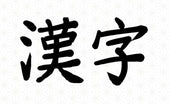
Kanji For Kanji - 漢字
Inception time. Which kanji compose the kanji of "kanji"? The kanji for "kanji" is actually pretty straightforward. I...
-

How to Memorize Katakana Easily: 9 Tips for Beginners
For those diving into Japanese, mastering hiragana and katakana is the first significant challenge. While hiragana o...
-

Complete Hiragana and Katakana Chart With All 112 Characters
The very first step for everybody who wants to learn Japanese is to study the hiragana and katakana chart (before lea...
-
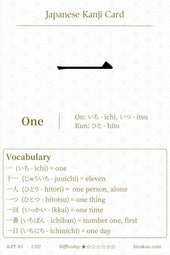
JLPT N5 Kanji: Kanji For One 一 (ichi)
Probably one the most simple kanji to remember, the kanji for 'one' is simply written '一'. Let's see its readings and...
-
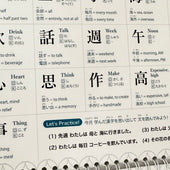
How Long Does It Take to Learn Kanji? A Beginner's Guide
Ask any Japanese student what's the scariest part of learning the language, and they'll say kanji. And they're righ...
-

Is it Necessary to Learn Kanji? The Last Answer You'll Ever Need
Many beginners in Japanese wonder whether they should really learn kanji. I know this, because I also wondered when s...
-

How Long Does it Take to Learn Hiragana and Katakana?
As a beginner in Japanese, your first step is diving into the alphabets of Hiragana and Katakana. These are the build...
-

13 Best YouTube Channels to Learn Japanese, From Beginner to Intermediate
YouTube can be an incredible resource for learning Japanese. And best of all, it's free. So we've compiled a list of ...
-
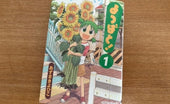
Top 10 Manga for Japanese Language Learners: From Beginners to Intermediates!
If you're learning Japanese, chances are you're interested in manga. So instead of reading texts about Tanaka-san s...
-
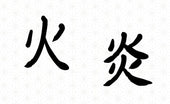
Kanji für „Feuer“ auf Japanisch: 火 oder 炎?
Willkommen zu unserer aufschlussreichen Erkundung des japanischen Kanji! Heute entfachen wir unser Verständnis ein...
-

Der vollständige Leitfaden zu Ländernamen auf Japanisch: Sagen Sie sie richtig und sprechen Sie sie richtig aus!
Egal, ob Sie eine Reise planen, Japanisch lernen oder einfach nur wissen möchten, wie verschiedene Länder in einer an...
-
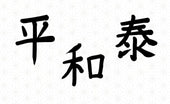
Kanji für Frieden: 平, 和, 泰 – Die Symbole der Harmonie
Sie fragen sich vielleicht, was die japanischen Symbole für „Frieden“ sind. In diesem Artikel tauchen wir tief in ...
-
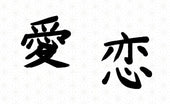
Kanji für „Liebe“: Wie und wann man 愛 und 恋 verwendet
Willkommen auf unserer Reise in die Welt des japanischen Kanji! Heute beschäftigen wir uns mit einem der herzerwär...
-
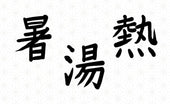
Kanji für „Hot“ auf Japanisch: 暑, 湯 und 熱 – Ein umfassender Leitfaden
Willkommen auf unserer Reise in die Welt des japanischen Kanji! Heute werden wir uns mit einem spannenden und wese...
-
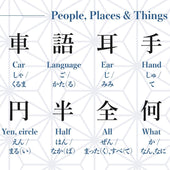
JLPT N5 Kanji-Liste – Alle 112 Zeichen, die Sie kennen müssen
Wenn Sie sich zum Ziel gesetzt haben, die JLPT N5-Prüfung zu bestehen, ist eines sicher: Ein fester Umgang mit Kanji ...

![へ – Marking Direction ‘Toward’ in Japanese [JLPT N5]](http://hirakan.com/cdn/shop/articles/he-marking-direction.jpg?v=1762667986&width=170)
![の – Possession and Noun Linking in Japanese [JLPT N5]](http://hirakan.com/cdn/shop/articles/no-possession-and-noun-linking.jpg?v=1761961297&width=170)
![を – Marking the Direct Object in Japanese [JLPT N5]](http://hirakan.com/cdn/shop/articles/o-direct-object.jpg?v=1761960990&width=170)
![が – Marking the Subject ('Who/What') in Japanese [JLPT N5]](http://hirakan.com/cdn/shop/articles/ga-subject-marker_60f30f70-6ca5-47ee-9a00-3646195d7d3c.jpg?v=1761386355&width=170)
![は (wa) – Topic Marker and Contrast in Japanese [JLPT N5]](http://hirakan.com/cdn/shop/articles/wa-topic-marker.jpg?v=1761385996&width=170)
![じゃない・ではありません – Expressing 'Is/Was Not' in Japanese [JLPT N5]](http://hirakan.com/cdn/shop/articles/janai-dehaarimasen_2594963b-531e-4f4d-a9b0-361010e0a720.jpg?v=1760865884&width=170)
![だ・です/だった・でした – Saying ‘to be’ in Japanese [JLPT N5]](http://hirakan.com/cdn/shop/articles/da-desu-datta-deshita_58bbc732-53fd-48da-83c7-4e477e7cc0b2.jpg?v=1760864506&width=170)























